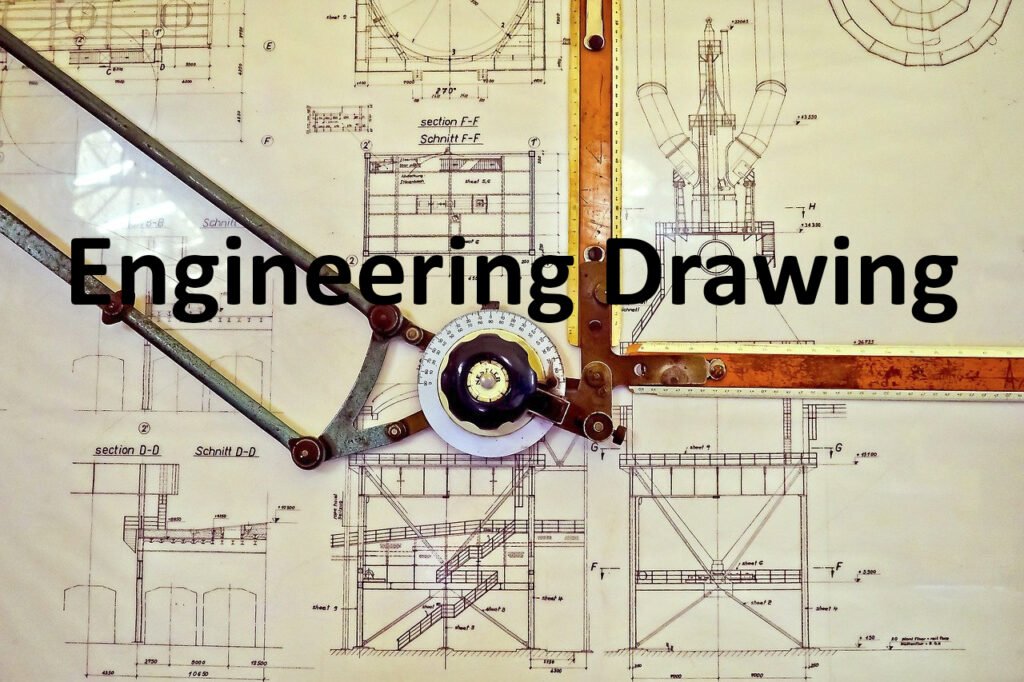Table of Contents
Engineering Drawing – Lab and Home Assignments /इंजीनियरिंग ड्राइंग – लैब और होम असाइनमेंट
Submission Date – 22/01/2025, 2-3 PM
Lab Assignment 1 [Engineering Curves I]
- A point moves in a plane in such a way that the sum of its distances from two fixed points 100 mm apart is 130 mm. Name and draw the locus of this point.
- The major axis of an ellipse is 110 mm and minor axis is 70 mm long. Draw an ellipse by concentric circle method.
- Inscribe the largest possible ellipse in a rectangle of sides 160 mm and 100 mm.
- A parabolic arch has a span1# of 160 mm and a maximum rise of 100 mm. Draw a curve using Tangent method.
- Draw a parabola of base 120 mm and axis 80 mm by oblong method.
- Draw a hyperbola when its asymptotes are inclined at 60o to each other and passes through a point P. The point P is at a distance of 40 mm and 50 mm from the asymptotes.
Lab Assignment 2 [Engineering Curves II]
- Draw a cycloid of a circle of diameter 50 mm for one revolution. Also, draw a tangent and a normal to the curve at a point 35 mm above the base line.
- Draw an epicycloid of a circle of diameter 50 mm, which rolls outside a circle of diameter 180 mm for one revolution. Also, draw a tangent and a normal to the epicycloid at a point 135 mm from the centre of the directing circle.
- Draw a hypocycloid of a circle of diameter 50 mm, which rolls inside a circle of diameter 180 mm for one revolution. Also, draw a tangent and a normal to the hypocycloid at a point 50 mm from the centre of the directing circle.
- Draw an involute of a circle of diameter 50 mm. Also draw normal and tangent at a point 100 mm from the centre of the circle.
- Draw an Archimedean spiral of 1½ convolutions for the shortest and the greatest radii as 20 mm and 90 mm, respectively. Also, draw a tangent and a normal to the curve at a point 50 mm from the pole.
- Draw a logarithmic spiral of one convolution, when the shortest distance is 16 mm and ratio of the length of radius vectors enclosing an angle of 30° is 9:8. Also, draw a tangent and a normal to the curve at a point 50 mm from the pole.
Lab Assignment 3 [Engineering Scales]
- An area of 49 square centimetres on a map represents an area of 16 sq. m on a field. Draw a scale long enough to measure 8 m. Mark a distance of 6 m 9 dm on the scale.
- The distance between two stations by road is 200 km and it is represented on a certain map by a 5 cm long line. Find the R.F. and construct a diagonal scale showing single kilometre and long enough to measure up to 600 km. Show a distance of 467 km on this scale.
- On a railway map, an actual distance of 36 miles between two stations is represented by a line 10 cm long. Draw a plain scale to show mile and long enough to read up to 60 miles. Also draw a comparative scale attached to it to show kilometre and read up to 90 kilometres. On the scale show the distance in kilometres equivalent to 46 miles. Take 1 mile = 1609 metres.
- Construct a ver nier scale of 1:40 to read metres, decimetres and centimetres and long enough to measure up to 6 m. Mark a distance of 5.76 m on it.
Lab Assignment 4 [Orthographic Projections]
Lab Assignment 5 [Isometric Projections]
Sheet Problems for Isometric Projections Mech 2024
Lab Assignment 6 [Projection of Straight Lines]
Sheet_Problems_Lines Mech 2024
Lab Assignment 7 [Projection of Planes]
Sheet Problems for Projection of Planes Mech 2024
Lab Assignment 8 [Projection of Solids, Section of Solids and Development of Lateral Surface]
- A cylinder, 60 mm diameter and 75 mm long, has its axis parallel to both the H.P. and the V.P. It is cut by a vertical section plane inclined at 30° to the V.P., so that the axis is cut at a point 40 mm from one of its ends and both the bases of the cylinder are partly cut. Draw its sectional front view and true shape of the section, also draw the development of the sectioned solid.
- A cone, base 70 mm diameter and axis 75 mm long is resting on its base on the H.P. It is cut by a section plane perpendicular to the V.P., inclined at 60° to the H.P. and cutting the axis at a point 35 mm from the apex. Draw its front view, sectional top view, sectional side view and true shape of the section, also draw the development of the sectioned solid.
- An equilateral triangular prism, base 50 mm side and height 100 mm is standing on the H.P. on its triangular face with one of the sides of that face inclined at 90° to the V.P. It is cut by an inclined plane in such a way that the true shape of the section is a trapezium of 50 mm and 12 mm parallel sides. Draw the projections and true shape of the section and find the angle which the cutting plane makes with the H.P, also draw the development of the sectioned solid.
- A pentagonal pyramid, base side 35 mm, length of axis 75 mm is resting on a base edge on the H.P. with a triangular face containing that edge being perpendicular to the V.P. and inclined to the H.P. at 60°. It is cut by a horizontal section plane whose V.T. passes through the mid-point of the axis. Draw the front view, sectional top view and add a profile view, also draw the development of the sectioned solid.
- Draw the projections of a cube of 25 mm long edges resting on the H.P on one of its corners with a solid diagonal perpendicular to the V.P.
Lab Assignment 9 [Interpenetration of Solids or Intersection of Surfaces]
- A vertical square prism, base 50 mm side is completely penetrated by a horizontal square prism, base 35 mm side so that their axes are 6 mm apart. The axis of the horizontal prism is parallel to the V.P., while the faces of both prisms are equally inclined to the V.P. Draw the projections of the prisms showing lines of intersection.
- A square pyramid of base sides 50 mm and height 60 mm. The sides of base are equally inclined with the VP. ft is penetrated by a horizontal triangular prism of sides 30 mm and 80 mm axis long. The axes of both solids are intersecting each other. The axis of triangular prism is 22 mm above H.P. and perpendicular to the VP. One of faces of triangular prism is perpendicular to the VP. Draw the top view, front view and side view showing the curve of the penetration.
- A vertical cylinder of 80 mm diameter is penetrated by another cylinder of 60 mm diameter, the axis of which is parallel to both the H.P. and the V.P. The two axes are 8 mm apart. Draw the projections showing curves of intersection.
- A vertical cone, diameter of base 75 mm and axis 100 mm long, is completely penetrated by a cylinder of 45 mm diameter. The axis of the cylinder is parallel to the H.P. and the V.P. and intersects the axis of the cone at a point 28 mm above the base. Draw the projections of the solids showing curves of intersection.



